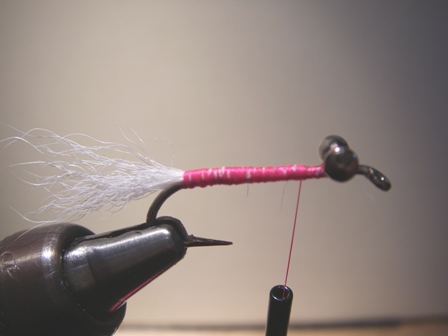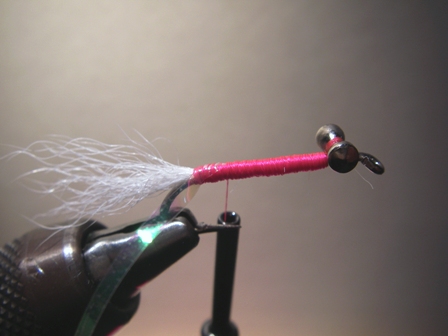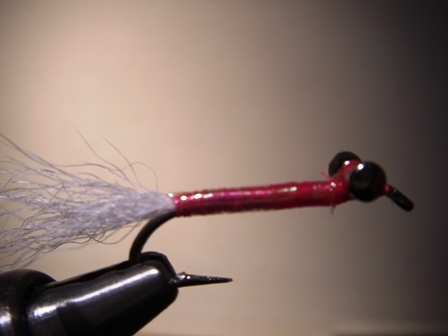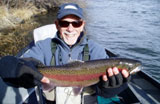Description
Ron and Jeanne English showed me this
simple fly a couple of years ago. While
there are many good shad pattern, this one
catches a lot of fish when drifted properly.
There is a shad clinic scheduled for May 16th,
with Al Smatsky. If you haven’t fished for
shad, or want to improve your skills at
hooking these hard fighting fish, be sure to
sign up for this clinic. The cost is $25,
and well worth it. Covered subjects include
rods, lines, leaders, flies, tactics, and
fish handling.
Tying Instructions
|
1. Cover
the front ¼ of the hook with
thread. Mount the eyes about
1/8“ behind the hook eye and on
top of the hook. This will cause
the hook to ride upside down,
which helps to minimize bottom
snags.
|
 |
|
|
|
2. Wrap
lead or substitute, if weight is
desired. Cover it with thread
wraps to secure it in place.
|
 |
|
|
|
|
3. Tie
in a small bunch of calf tail just above the barb of the hook which you should
have smashed by now. Fishing barbed shad hooks is unsafe. If, due to wind or an
errant cast, you happen to hook yourself, or if another angler sinks one in you,
although it still hurts, the de-barbed version will back out easily. The barbed
version is difficult and painful to remove.
|
 |
|
|
|
4. At
the same point as the tail, tie
in a strip of mylar. You can use
mylar tinsel, which comes on a
spool, or salt water pearl
flashabou.
5. Tie
in hot pink (or other color)
floss at the same point and wind
it forward to the rear of the
eyes; tie it off there..
6. Wrap
the mylar forward as an
overbody, and tie it off at the
same point as the floss.
7.
Form a head with the tying
thread, and whip finish. Apply
head cement or superglue, since
the thread will be slippery and
it helps to keep the eyes in
place.
|
 |
|
|
|
Useful
Tips for Shad Fishing
|
|
|
|
1. Keep it simple. You won’t need your gadget-laden
vest. All you need is your fishing
license, a small box of shad flies,
a spool of 8 or 10 pound maxima for
your leader, a forceps and a nipper.
2. Don’t use tapered leaders for this type of fishing. Your leader
should be short (6 feet) and stout. The
object is to get the fly down quickly for
the swing.
3. A good sink tip such as a Teeny 200 (for single-handed rods) will
do in most situations. For higher flows you
may have to go up to 250 or 300 grain lines.
|
|
|
|
|
Tying
Tips
|
1. When
tying on eyes (whether on the top or bottom
of the hook) just wrap diagonally between
the eyes and around the hook. Once you’ve
done this 5 or 6 times, wrap horizontally
around the eyes. This tightens up the
diagonal wraps. Don’t bother with the
“figure 8” method as it ends up not nearly
as tight. Always add superglue before
proceeding with the rest of the fly.
2. To
tie materials such as calf tail on the hook
without having it roll over to the other
side of the hook, use the “45 degree”
technique. See the “Tips, tricks, and
techniques” page on my website:
http://www.billcarnazzo.com/articles/fishfoolingdryflies.htm
3. When tying flies such as the one in this month’s article, it pays
to coat the body with a good, flexible
cement such as Dave’s Flexament or Softex.
You will get more use out of your flies by
taking this step.
|
|
|
|
|
|
|
|
 |
|

